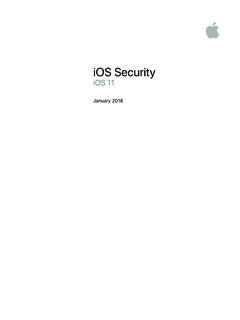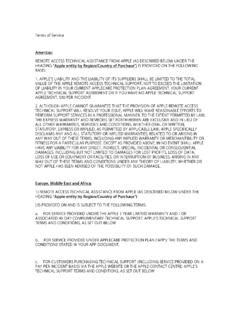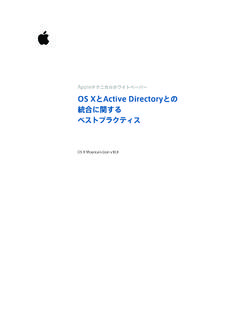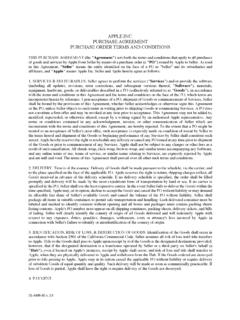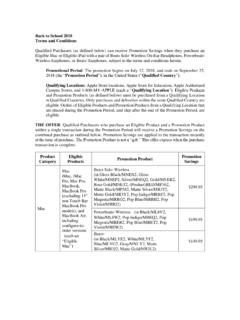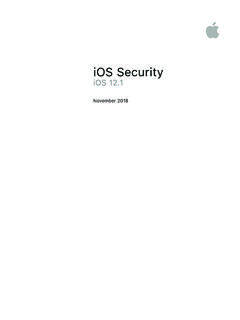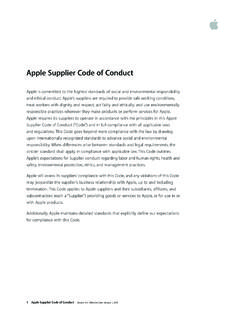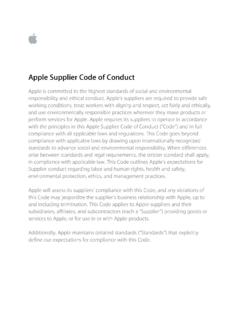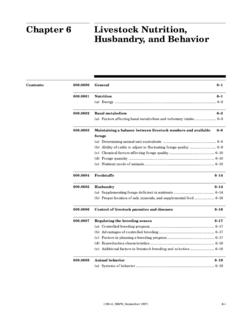Transcription of Learn how the Safari web browser protects your privacy.
1 Safari Privacy Overview Learn how the Safari web browser protects your privacy. November 2019 Introduction 3 ..Privacy by design 3 ..Protection from cross-site tracking 3 ..Ad measurement that respects user privacy 5 ..Minimizing data sharing with the Smart Search field 6 ..Browsing privately 7 ..Deleting history and other data 7 ..Secure payments on the web 8 ..Sync and sign-in features that keep the user in control 9 ..Extensions that respect user privacy 10 ..Improving Safari while respecting privacy 11 ..Conclusion Privacy Overview | November 20192 ContentsIntroduction Safari is the built-in browser on Mac, iPhone, iPad, and apple Watch. Fast and energy efficient, Safari delivers innovative features while also protecting user privacy. Safari is built to ensure websites keep working as expected while blocking unwanted cross-site tracking. Safari also minimizes the amount of data passed to third parties like search engines, and it provides many other features to help protect privacy like Private Browsing and secure password management.
2 Safari protects privacy without requiring users to change the default settings. Privacy by design Safari has been designed from the ground up to protect user privacy. Key privacy features like Intelligent Tracking Prevention (ITP) and fingerprinting defense are turned on by default, so there is no need to make changes in Settings or Safari preferences to benefit from these privacy protections. Safari minimizes the amount of data collected by apple and shared with third parties. Where possible, Safari s privacy protections are designed to process data on device. For example, ITP uses machine learning to classify tracking data locally so that browsing history isn t sent to apple . Safari also limits the amount of information passed to search engines when a user searches using the Smart Search field. And Safari is designed to provide users with transparency and control around data that is shared. For example, if a user visits a website that wants to access location using Location Services on the device, or use the camera or microphone, Safari will ask permission from the user before granting access.
3 Users can also customize these settings for each website to allow, not allow, or ask each time the site is visited. Safari is designed to hide the user s identity when sharing information with apple . Analytics data shared with apple is not attached to identifying information and, in some cases, is protected using differential privacy, a technique that obscures individual information while allowing apple to analyze broader trends in web-browsing behavior. And Safari implements security best practices to protect user data. Protection from cross-site tracking In the years since the web was created, technology has been developed to track user behavior across websites for advertising purposes. Users experience this tracking in action when they look at a product online and then ads for that product seem to follow them around the web. Tracking is pervasive; some websites include 100 or more trackers from different companies on a single page.
4 Safari Privacy Overview | November 20193 Key Safari Privacy Features Intelligent Tracking Prevention Intelligent Tracking Prevention uses on-device machine learning to block cross-site tracking, while still allowing websites to function normally. Smart Search field The Smart Search field minimizes the amount of data passed to third-party search engines. It doesn t send precise location data or cookies along with search data. Private Browsing mode Private Browsing doesn t save browsing history, protecting a user s privacy from other users who may share the same device. Seamless integration with apple Pay apple Pay is a privacy-centric payment method that doesn t share credit card numbers with apple or merchants, while offering industry-leading security. Passwords and syncing iCloud Keychain enables users to easily sync passwords, credit card numbers, and autofill information across devices while keeping that information secure and without signing users in to any other services.
5 Because tracking uses web technology that also provides features required for the proper operation of websites, simply blocking all of the functionality used for tracking can cause issues, including not being able to save sign-in information or remember items in a shopping cart. In iOS 11 and macOS High Sierra, Safari added a feature called Intelligent Tracking Prevention to address this problem. The goal of ITP is to limit tracking while still enabling websites to function normally. ITP works by learning which domains are used to track a user and then immediately isolating and purging the tracking data that they attempt to store on the user s device. The process of learning about domains uses machine learning and happens on device, so it doesn t share the user s browsing history information with apple . This on-device approach applies the same high standard to every website that is visited. And because ITP is turned on by default, there is no need to change anything in Settings or Safari preferences to receive tracking protection.
6 Social widgets embedded on other websites, such as Like buttons, Share buttons, and comment fields, can be used to track users even if they don t click them or use them. With ITP, Safari blocks this tracking by default, provides transparency and control, and asks users if they d like to allow social widgets to access their identity. For example, if a user interacts with an embedded social plug-in, it can request access to the user s information with a permission dialog such as this: Choosing Allow permits the social site to access the user s information while the user is browsing the news site. If the user navigates to a different site, the user will need to grant access again, which helps ensure that the user is in control. Fingerprinting defense In addition to blocking cookie-based tracking, Safari works to prevent advertisers and websites from using the unique combination of characteristics of a device to create a fingerprint to track the user online.
7 Some of these characteristics include the device and browser configuration and the fonts and plug-ins that have been installed. To combat fingerprinting, Safari presents a simplified version of the system configuration to trackers so more devices look identical, making it harder to single one out. And unlike some other browsers, Safari doesn t add any custom tracking headers or unique identifiers to web requests. On other browsers, these headers can include things like location, sign-in status, account information, features enabled, and other data that can be used for cross-site tracking. Safari Privacy Overview | November 20194 What are cookies? Cookies are small data files that websites save on a device. They can be used for a variety of purposes, including saving sign-in information so that a user can navigate the web without having to sign in to the same sites over and over again. They can also be used to store information about where users have been on the web for cross-site tracking.
8 What are first-party and third-party cookies? A cookie from a first-party website is saved to a user s device by a web page the user has visited. A third-party cookie is saved to the device by any other site or service, often for cross-site tracking. Why is Intelligent Tracking Prevention necessary? In 2005, Safari became the first browser to block third-party cookies by default. Since then, tracking companies have found new ways to track people using first-party cookies and other data. Intelligent Tracking Prevention was created to block tracking regardless of what kind of data is used. With macOS, Safari no longer supports most plug-ins, so they can t be used to attempt to uniquely identify a user. Fingerprinting protection is built into Safari and doesn t require any user action. Together, these anti-fingerprinting protections make a user s device look much more like other devices, providing herd immunity that dramatically reduces data companies ability to identify a single device uniquely and all without compromising the web-browsing experience.
9 apple believes the role of the web browser is to act as an agent on behalf of the user. This means that Safari will continue to evolve to prevent new forms of tracking. Ad measurement that respects user privacy apple understands that advertising is important for the economy of the web. Online advertising should not require privacy-invasive tracking and neither should advertising measurement. Unfortunately, ad click measurement has traditionally used tracking technology that infringes on user privacy. To address this, Safari now includes the ability to offer Private Click Measurement, an innovative way of doing ad click measurement that prevents cross-site tracking but still enables advertisers to measure the effectiveness of web campaigns. It is built into the browser itself and runs on device, which means that neither advertisers, merchants, nor apple can see what ads are clicked or which purchases are made. This solution avoids placing trust in any of the parties involved the ad network, the merchant, or other intermediaries so none of them are able to track users as they click on ads and make purchases in Safari .
10 Private Click Measurement is built around a handful of privacy principles. First, a user should not be tracked for the purpose of ad click measurement. Second, only sites a user visits should be involved in measuring ad clicks and conversions not third-party data companies. Third, the browser should act on the behalf of users and do its best to preserve their privacy. And fourth, the browser vendor should not Learn about which ads users click or what they buy. By allowing the browser to store information only on the device and report directly on the ad click, tracking technology is removed from the process. By limiting the amount of data collected by third parties, ad measurement is done in a privacy-preserving way without cross-site tracking. Matching of an ad click with a purchase is all done on device and is not reported to apple . apple has proposed Private Click Measurement as a new web standard to the World Wide Web Consortium.
